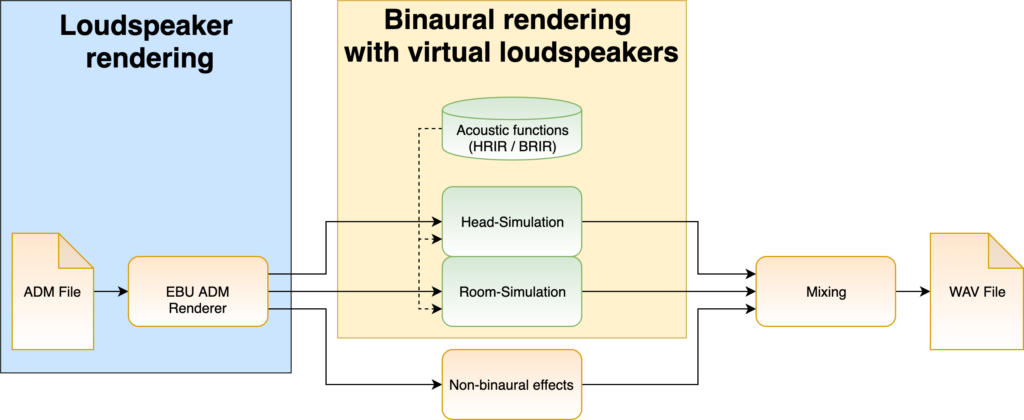Since the first release of the EBU ADM Renderer, the implementation of 3D audio via headphones through binaural technology has been a desired functionality.
Binaural technology provides the ability to easily deliver three-dimensional, immersive content to the listener. All the listener needs for this is headphones. This makes it possible to listen to spatially demanding productions without complex loudspeaker systems and thus make them accessible to a wider audience. Thanks to the usage of Next Generation Audio, this does not even require a separate production.
The basic idea of binaural technology is to integrate the acoustic functions of the human head and the listening environment into the headphone signal. This simulates all the necessary information for spatial hearing which is normally not available during headphone playback. As a result, the listener gets the impression of a three-dimensional sound field which makes it even possible to position auditory events outside the listener’s head.
As part of a recently completed master thesis on this topic at IRT, a first developer version for binaural rendering for the EBU ADM Renderer was developed. It uses the existing functionalities of the EBU ADM renderer, mainly the ability to render ADM based files for loudspeaker-setups, and extends them to simulate a virtual, three-dimensional loudspeaker setup around the listener. To do this, the binaural rendering is divided into three parts to effectively simulate the influences of the listener’s head and a virtual listening studio. In addition, the third rendering part enables the inclusion of headphone specific, non-binaural effects, especially the localization of events in the head of the listener, the so-called in-head localization.

Current structure of the binaural rendering
To better understand the function of the individual rendering parts, here is an excerpt from the object-based radio play “Forest”*. First the complete binaural mix and afterwards all rendering parts individually. Make sure to listen with headphones.
The complete binaural mix:
Only the head simulation:
Only the room simulation:
Only the non-binaural effects:
– In comparison to the complete rendering, it should be noticeable that with
only the head-simulation all objects are perceived much closer, or even inside the
head, due to the missing room simulation.
– The room simulation serves to add an audible depth to the head simulation.
Compared to the head simulation, it therefore gives only a very limited auditory
impression when listened to separately.
– In the case of this radio play, the narrator was not binaurally rendered,
allowing his voice to be located directly inside the head. This can be used to
support the separation of the intra- and the extra-diegetic level on a tonal level.
As this example certainly shows, binaural reproduction is particularly suitable for productions with a strong spatial component with sound sources all around the listener, such as radio dramas or certain music genres.
We are sure that the combination of Next Generation Audio and binaural technology will make an important contribution to the distribution of exciting spatial productions and looking forward to present you a first release soon after further development.
* Woodcock, J., Pike, C., Coleman, P., Melchior, F., Franck, A. and Hilton, A. (2016) “S3A Object-Based Audio Drama dataset”, DOI 10.17866/rd.salford.3043921

